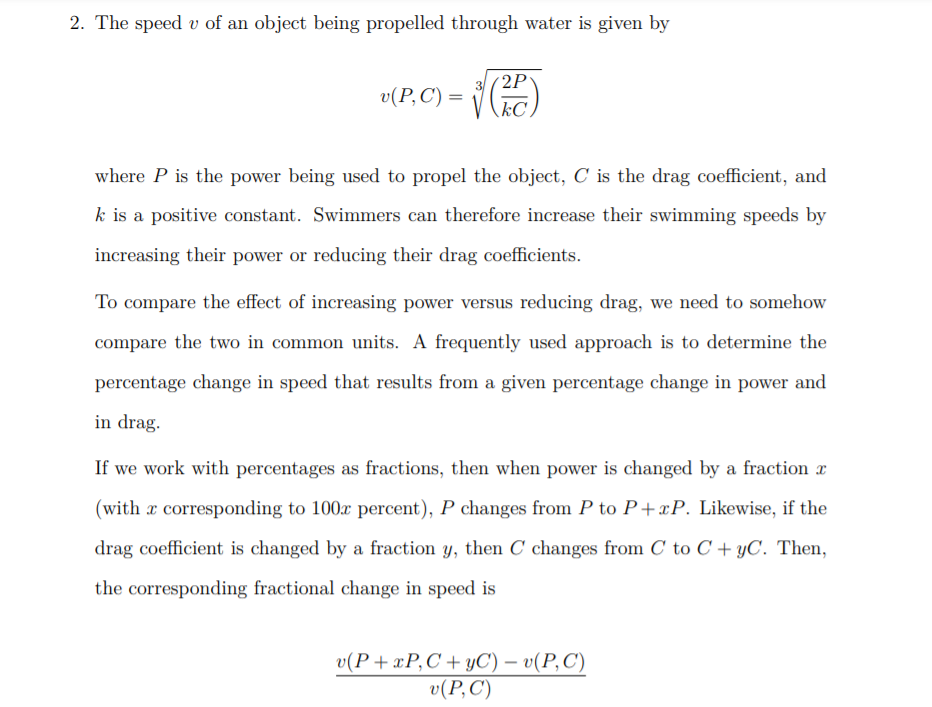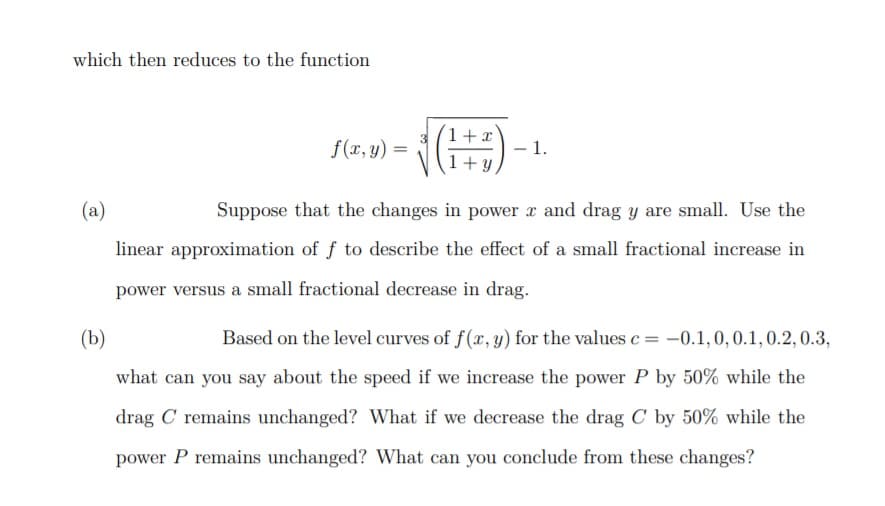which then reduces to the function 1+x f(x, y) = 1. + y (a) Suppose that the changes in power x and drag y are small. Use the linear approximation of f to describe the effect of a small fractional increase in power versus a small fractional decrease in drag. (b) Based on the level curves of f(r, y) for the values c= -0.1,0,0.1,0.2, 0.3, what can you say about the speed if we increase the power P by 50% while the drag C remains unchanged? What if we decrease the drag C by 50% while the power P remains unchanged? What can you conclude from these changes?
which then reduces to the function 1+x f(x, y) = 1. + y (a) Suppose that the changes in power x and drag y are small. Use the linear approximation of f to describe the effect of a small fractional increase in power versus a small fractional decrease in drag. (b) Based on the level curves of f(r, y) for the values c= -0.1,0,0.1,0.2, 0.3, what can you say about the speed if we increase the power P by 50% while the drag C remains unchanged? What if we decrease the drag C by 50% while the power P remains unchanged? What can you conclude from these changes?
Elements Of Electromagnetics
7th Edition
ISBN:9780190698614
Author:Sadiku, Matthew N. O.
Publisher:Sadiku, Matthew N. O.
ChapterMA: Math Assessment
Section: Chapter Questions
Problem 1.1MA
Related questions
Question
100%

Transcribed Image Text:2. The speed v of an object being propelled through water is given by
3(2P
kC.
v(P, C) =
where P is the power being used to propel the object, C is the drag coefficient, and
k is a positive constant. Swimmers can therefore increase their swimming speeds by
increasing their power or reducing their drag coefficients.
To compare the effect of increasing power versus reducing drag, we need to somehow
compare the two in common units. A frequently used approach is to determine the
percentage change in speed that results from a given percentage change in power and
in drag.
If we work with percentages as fractions, then when power is changed by a fraction x
(with x corresponding to 100x percent), P changes from P to P+xP. Likewise, if the
drag coefficient is changed by a fraction y, then C changes from C to C + yC. Then,
the corresponding fractional change in speed is
v(P+zР,С +УС) — v(Р,С)
v(P,C)

Transcribed Image Text:which then reduces to the function
1+x
f(x, y)
1.
+ y
(a)
Suppose that the changes in power x and drag y are small. Use the
linear approximation of f to describe the effect of a small fractional increase in
power versus a small fractional decrease in drag.
(b)
Based on the level curves of f(x, y) for the values c = -0.1,0, 0.1, 0.2, 0.3,
what can you say about the speed if we increase the power P by 50% while the
drag C remains unchanged? What if we decrease the drag C by 50% while the
power P remains unchanged? What can you conclude from these changes?
Expert Solution
This question has been solved!
Explore an expertly crafted, step-by-step solution for a thorough understanding of key concepts.
This is a popular solution!
Trending now
This is a popular solution!
Step by step
Solved in 4 steps with 4 images

Knowledge Booster
Learn more about
Need a deep-dive on the concept behind this application? Look no further. Learn more about this topic, mechanical-engineering and related others by exploring similar questions and additional content below.Recommended textbooks for you

Elements Of Electromagnetics
Mechanical Engineering
ISBN:
9780190698614
Author:
Sadiku, Matthew N. O.
Publisher:
Oxford University Press

Mechanics of Materials (10th Edition)
Mechanical Engineering
ISBN:
9780134319650
Author:
Russell C. Hibbeler
Publisher:
PEARSON

Thermodynamics: An Engineering Approach
Mechanical Engineering
ISBN:
9781259822674
Author:
Yunus A. Cengel Dr., Michael A. Boles
Publisher:
McGraw-Hill Education

Elements Of Electromagnetics
Mechanical Engineering
ISBN:
9780190698614
Author:
Sadiku, Matthew N. O.
Publisher:
Oxford University Press

Mechanics of Materials (10th Edition)
Mechanical Engineering
ISBN:
9780134319650
Author:
Russell C. Hibbeler
Publisher:
PEARSON

Thermodynamics: An Engineering Approach
Mechanical Engineering
ISBN:
9781259822674
Author:
Yunus A. Cengel Dr., Michael A. Boles
Publisher:
McGraw-Hill Education

Control Systems Engineering
Mechanical Engineering
ISBN:
9781118170519
Author:
Norman S. Nise
Publisher:
WILEY

Mechanics of Materials (MindTap Course List)
Mechanical Engineering
ISBN:
9781337093347
Author:
Barry J. Goodno, James M. Gere
Publisher:
Cengage Learning

Engineering Mechanics: Statics
Mechanical Engineering
ISBN:
9781118807330
Author:
James L. Meriam, L. G. Kraige, J. N. Bolton
Publisher:
WILEY